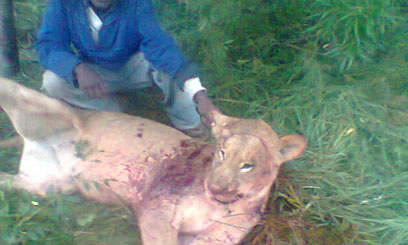
The Kenya Wildlife Service said the incident occurred at the Elangata Ngima area, in Kuku Group Ranch/FILE
The Kenya Wildlife Service said the incident occurred at the Elangata Ngima area, in Kuku Group Ranch.
“The morans had mobilised themselves to pursue a pride of lions that had killed a cow last evening at 7pm. They were seriously injured while pursuing the pride of lions,” said KWS Communication Officer Paul Udoto.
One of the lions was also killed during the attack.
Elsewhere in Laikipia Nature Conservancy, a suspected poacher was killed during a fierce gunfight with KWS rangers.
An AK 47 rifle was recovered at the scene while his accomplice escaped with injuries.
The rangers were responding to gunshots within the ranch when they encountered two suspected poachers.
The rangers are looking for an elephant which was injured by the suspected poachers.
“A major hunt for the suspect who fled is underway,” said Udoto.
At the same time, a lion which had strayed from the same conservancy and which has been roaming in Baringo County is still being monitored by KWS team of rangers and capture personnel.
It is currently at Loruk area near Lake Baringo.
“We call upon members of the public to desist from killing wild animals and instead report to KWS as wild animals can be very dangerous,” KWS Communication Officer Paul Udoto said.
KWS on Friday decried the loss of lions to both poachers and incidences of human wildlife conflict.
KWS Assistant Director Paul Mbugua told journalists in Nairobi that the estimated population of lions in the country stands at 2000 with 30 of them at the Nairobi National Park.
“KWS is concerned that rapid population growth has seen humans encroach on wildlife migratory paths leading to loss of wildlife, including lions,” Mbugua said.
According to the wildlife agency, the country has lost nine lions, six alone in the past week and four elephants since January due to conflicts with people.
Data from KWS also indicates that total wildlife mortality resulting from human wildlife conflict since January is 50, including 26 primates.
Mbugua noted that areas that were once inhabited by wildlife have now been occupied by humans leading to increasing conflict.
“Since the beginning of the year, 18 people have lost their lives as a result of human wildlife conflict, while another 65 have suffered injuries,” the assistant director said.
On June 19th, angry residents at a local village in the outskirts of Nairobi speared to death a total of 6 lions.
The East African nation has been losing 100 lions a year for the past 7 years, leaving the country with just 2000 of its famous big cats, meaning that the country could have no wild lions at all in 20 years.
Conservationists have blamed habitat destruction, disease and conflict with humans for the lion population decline.
The number of elephants has reduced from a high of 160,000 in 1970s to below 30,000. KWS said between the 1970s and 1980s Kenya lost over 80 per cent of her elephants, mainly due to intensive poaching of elephants for ivory.
Also affected are the Black Rhinos whose number declined from 20,000 in 1970 to current 577 in 2011.
KWS Senior Warden James Nyakundi said that they are encouraging communities with big chunks of land close to the wildlife areas to engage in ecotourism.
“We know that if the local residents derive direct benefits from the wildlife they will see value of their conservation,” he said.











































